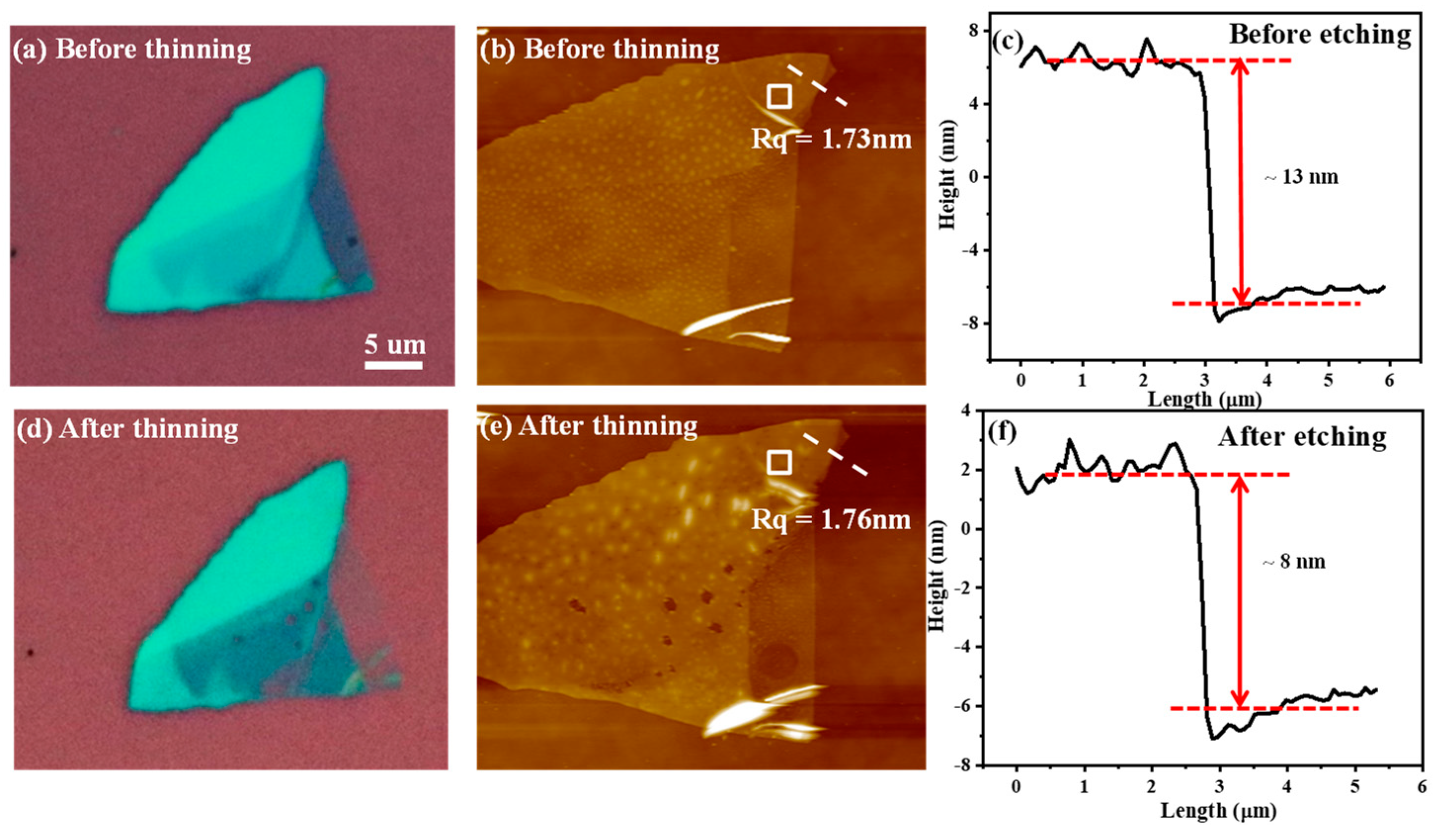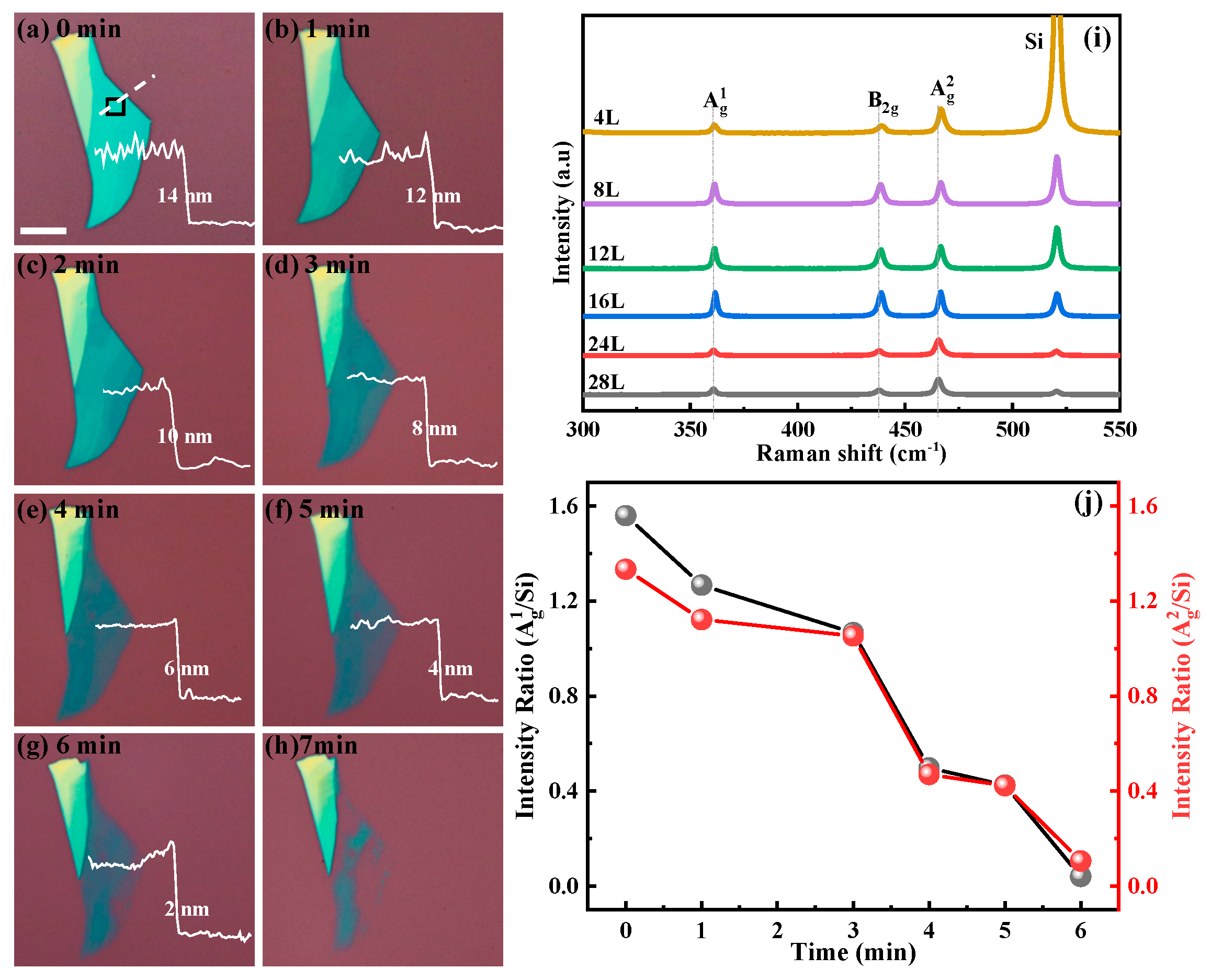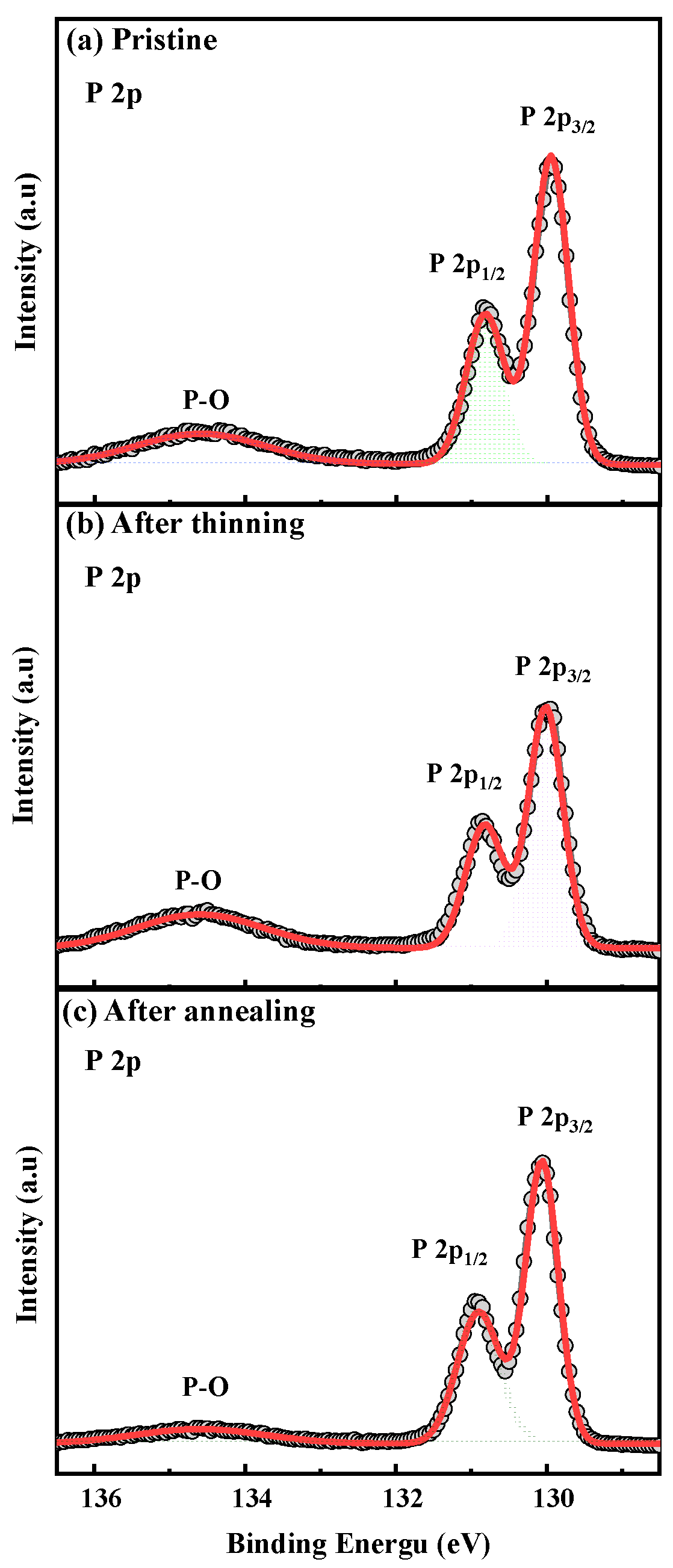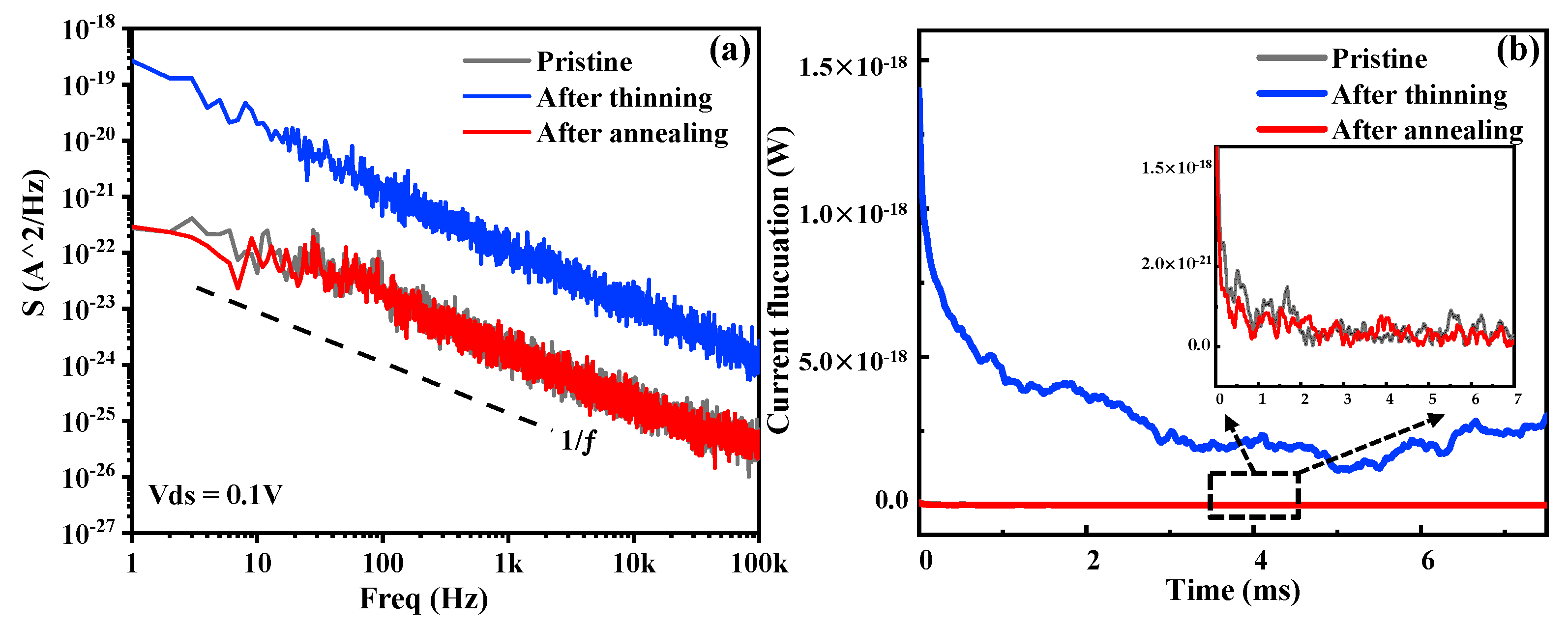Study on Black Phosphorus Characteristics Using a Two-Step Thinning Method
Abstract
:1. Introduction
2. Experimental Section
Materials and Methods
3. Results and Discussion
3.1. Material Characteristics
3.2. Electronic Performance
3.3. Noise Performance
4. Conclusions
Supplementary Materials
Author Contributions
Funding
Institutional Review Board Statement
Informed Consent Statement
Data Availability Statement
Acknowledgments
Conflicts of Interest
References
- Tran, V.; Soklaski, R.; Liang, Y.; Yang, L. Layer-controlled band gap and anisotropic excitons in few-layer black phosphorus. Phys. Rev. B 2014, 89, 235319. [Google Scholar] [CrossRef] [Green Version]
- Li, L.; Yu, Y.; Ye, G.J.; Ge, Q.; Ou, X.; Wu, H.; Feng, D.; Chen, X.H.; Zhang, Y. Black phosphorus field-effect transistors. Nat. Nanotechnol. 2014, 9, 372–377. [Google Scholar] [CrossRef] [PubMed] [Green Version]
- Qiao, J.; Kong, X.; Hu, Z.-X.; Yang, F.; Ji, W. High-mobility transport anisotropy and linear dichroism in few-layer black phosphorus. Nat. Commun. 2014, 5, 4475. [Google Scholar] [CrossRef] [Green Version]
- Choi, S.J.; Kim, B.-K.; Lee, T.-H.; Kim, Y.H.; Li, Z.; Pop, E.; Kim, J.-J.; Song, J.H.; Bae, M.-H. Electrical and Thermoelectric Transport by Variable Range Hopping in Thin Black Phosphorus Devices. Nano Lett. 2016, 16, 3969–3975. [Google Scholar] [CrossRef]
- Jin, L.; Hu, P.; Wang, Y.; Wu, L.; Qin, K.; Cheng, H.; Wang, S.; Pan, B.; Xin, H.; Zhang, W.; et al. Fast-acting black-phosphorusassisted depression therapy with low toxicity. Adv. Mater. 2020, 32, 1906050. [Google Scholar] [CrossRef]
- Li, Z.; Hu, Y.; Fu, Q.; Liu, Y.; Wang, J.; Song, J.; Yang, H. NIR/ROS-responsive black phosphorus QD vesicles as immunoad-juvant carrier for specific cancer photodynamic immunotherapy. Adv. Funct. Mater. 2019, 30, 1905758. [Google Scholar] [CrossRef]
- Liu, M.D.; Yu, Y.; Guo, D.K.; Wang, S.B.; Li, C.X.; Gao, F.; Zhang, C.; Xie, B.R.; Zhong, Z.; Zhang, X.Z. Integrationofa Porous Coordination Network and Black Phosphorus Nanosheets Forimproved Photodynamic Therapy of Tumor. Nanoscale 2020, 12, 8890–8897. [Google Scholar] [CrossRef] [PubMed]
- Ge, X.; Xia, Z.; Guo, S. Recent Advances on Black Phosphorus for Biomedicine and Biosensing. Adv. Funct. Mater. 2019, 29, 1900318. [Google Scholar] [CrossRef]
- Youngblood, N.; Chen, C.; Koester, S.J.; Li, M. Waveguide-integrated black phosphorus photodetector with high responsivity and low dark current. Nat. Photon. 2015, 9, 247–252. [Google Scholar] [CrossRef]
- Xu, M.; Gu, Y.; Peng, R.; Youngblood, N.; Li, M. Black phosphorus mid-infrared photodetectors. Appl. Phys. A 2017, 123, 130. [Google Scholar] [CrossRef]
- Fan, S.; Qiao, J.; Lai, J.; Hei, H.; Feng, Z.; Zhang, Q.; Zhang, D.; Wu, S.; Hu, X.; Sun, D.; et al. Wet Chemical Method for Black Phosphorus Thinning and Passivation. ACS Appl. Mater. Interfaces 2019, 11, 9213–9222. [Google Scholar] [CrossRef]
- Jeong, M.-H.; Kwak, D.-H.; Ra, H.-S.; Lee, A.-Y.; Lee, J.-S. Realizing Long-Term Stability and Thickness Control of Black Phosphorus by Ambient Thermal Treatment. ACS Appl. Mater. Interfaces 2018, 10, 19069–19075. [Google Scholar] [CrossRef] [PubMed]
- Clark, N.; Nguyen, L.; Hamer, M.J.; Schedin, F.; Lewis, E.A.; Prestat, E.; Garner, A.; Cao, Y.; Zhu, M.; Kashtiban, R.; et al. Scalable Patterning of Encapsulated Black Phosphorus. Nano Lett. 2018, 18, 5373–5381. [Google Scholar] [CrossRef] [Green Version]
- Liu, X.; Chen, K.; Wells, S.A.; Balla, I.; Zhu, J.; Wood, J.D.; Hersam, M.C. Scanning Probe Nanopatterning and Layer-by-Layer Thinning of Black Phosphorus. Adv. Mater. 2017, 29, 1604121. [Google Scholar] [CrossRef]
- Robbins, M.C.; Namgung, S.; Oh, S.-H.; Koester, S.J. Cyclical Thinning of Black Phosphorus with High Spatial Resolution for Heterostructure Devices. ACS Appl. Mater. Interfaces 2017, 9, 12654–12662. [Google Scholar] [CrossRef] [PubMed]
- Pei, J.; Gai, X.; Yang, J.; Wang, X.; Yu, Z.; Choi, D.-Y.; Luther-Davies, B.; Lu, Y. Producing airstable monolayers of phos-phorene and their defect engineering. Nat. Commun. 2016, 7, 10450. [Google Scholar] [CrossRef] [PubMed] [Green Version]
- Sruthi, K.; Taimur, A.; Sivacarendran, B.; Collis, G.E.; Vipul, B.; Igor, A.; Sharath, S.; Madhu, B.; Sumeet, W. Effects of plas-ma-treatment on the electrical and optoelectronic properties of layered black phosphorus. Appl. Mater. Today 2018, 12, 244–249. [Google Scholar]
- Faraone, G.; Sipala, R.; Mariani, M.; Martella, C.; Bonera, E. Probing the laser ablation of black phosphorus by raman spec-troscopy. J. Phys. Chem. C 2021, 125, 8704–8711. [Google Scholar] [CrossRef]
- Lu, W.; Nan, H.; Hong, J.; Chen, Y.; Zhu, C.; Liang, Z.; Ma, X.; Ni, Z.; Jin, C.; Zhang, Z. Plasma assisted fabrication of mon-olayer phosphorene and its Raman characterization. Nano Res. 2014, 7, 853–859. [Google Scholar] [CrossRef] [Green Version]
- Kwon, H.; Seo, S.W.; Kim, T.G.; Lee, E.S.; Lanh, P.T.; Yang, S.; Ryu, S.; Kim, J.W. Ultrathin and Flat Layer Black Phosphorus Fabricated by Reactive Oxygen and Water Rinse. ACS Nano 2016, 10, 8723–8731. [Google Scholar] [CrossRef] [PubMed]
- Kim, S.; Jung, Y.; Lee, J.-Y.; Lee, G.-H.; Kim, J. In situ thickness control of black phosphorus field-effect transistors via ozone treatment. Nano Res. 2016, 9, 3056–3065. [Google Scholar] [CrossRef]
- Wood, J.D.; Wells, S.A.; Jariwala, D.; Chen, K.-S.; Cho, E.; Sangwan, V.K.; Liu, X.; Lauhon, L.; Marks, T.J.; Hersam, M.C. Effective Passivation of Exfoliated Black Phosphorus Transistors against Ambient Degradation. Nano Lett. 2014, 14, 6964–6970. [Google Scholar] [CrossRef] [PubMed] [Green Version]
- Island, J.; Steele, G.A.; Van Der Zant, H.S.J.; Castellanos-Gomez, A. Environmental instability of few-layer black phosphorus. 2D Mater. 2015, 2, 011002. [Google Scholar] [CrossRef] [Green Version]
- Castellanos-Gomez, A.; Vicarelli, L.; Prada, E.; Island, J.O.; Narasimha-Acharya, K.L.; Blanter, S.I.; Groenendijk, D.J.; Buscema, M.; Steele, G.A.; Alvarez, J.V.; et al. Isolation and characterization of few-layer black phosphorus. 2D Mater. 2014, 1, 025001. [Google Scholar] [CrossRef]
- Favron, A.; Gaufrès, E.; Fossard, F.; Phaneuf-L’Heureux, A.-L.; Tang, N.Y.-W.; Levesque, P.; Loiseau, A.; Leonelli, R.; Francoeur, S.; Martel, R. Photooxidation and quantum confinement effects in exfoliated black phosphorus. Nat. Mater. 2015, 14, 826–832. [Google Scholar] [CrossRef] [PubMed]
- Zhu, X.; Zhang, T.; Sun, Z.; Chen, H.; Guan, J.; Chen, X.; Ji, H.; Du, P.; Yang, S. Black Phosphorus Revisited: A Missing Metal-Free Elemental Photocatalyst for Visible Light Hydrogen Evolution. Adv. Mater. 2017, 29, 1605776. [Google Scholar] [CrossRef]
- Zhou, Q.; Chen, Q.; Tong, Y.; Wang, J. Light-Induced Ambient Degradation of Few-Layer Black Phosphorus: Mechanism and Protection. Angew. Chem. Int. Ed. Eng. 2016, l55, 11437–11441. [Google Scholar] [CrossRef] [PubMed]
- Haratipour, N.; Koester, S.J. Ambipolar Black Phosphorus MOSFETs with Record n-Channel Transconductance. IEEE Electron Device Lett. 2015, 37, 103–106. [Google Scholar] [CrossRef] [Green Version]
- Jia, J.; Jang, S.K.; Lai, S.; Xu, J.; Choi, Y.J.; Park, J.-H.; Lee, S. Plasma-Treated Thickness-Controlled Two-Dimensional Black Phosphorus and Its Electronic Transport Properties. ACS Nano 2015, 9, 8729–8736. [Google Scholar] [CrossRef]
- Yang, S.; Kim, A.; Park, J.; Kwon, H.; Lanh, P.T.; Hong, S.; Kim, K.J.; Kim, J.W. Thermal annealing of black phosphorus for etching and protection. Appl. Surf. Sci. 2018, 457, 773–779. [Google Scholar] [CrossRef]
- Han, C.; Hu, Z.; Carvalho, A.; Guo, N.; Zhang, J.; Hu, F.; Xiang, D.; Wu, J.; Lei, B.; Wang, L.; et al. Oxygen induced strong mobility modulation in few-layer black phosphorus. 2D Mater. 2017, 4, 021007. [Google Scholar] [CrossRef]
- Bao, W.; Cai, X.; Kim, D.; Sridhara, K.; Fuhrer, M.S. High mobility ambipolar MoS2 field-effect transistors: Substrate and die-lectric effects. Appl. Phys. Lett. 2013, 102, 042104. [Google Scholar] [CrossRef] [Green Version]
- Dutta, P.; Horn, P.M. Low-frequency fluctuations in solids: 1/f noise. Rev. Mod. Phys. 1981, 53, 497. [Google Scholar] [CrossRef] [Green Version]
- Balandin, A.A. Low-frequency 1/f noise in graphene devices. Nat. Nanotechnol. 2013, 8, 549. [Google Scholar] [CrossRef]
- Lu, Q.; Yu, L.; Liu, Y.; Zhang, J.; Han, G.; Hao, Y. Low-Noise Mid-Infrared Photodetection in BP/h-BN/Graphene van der Waals Heterojunctions. Materials 2019, 12, 2532. [Google Scholar] [CrossRef] [Green Version]
- Zahid Hossain, M.; Rumyantsev, S.; Shur, M.S.; Balandin, A.A. Reduction of 1/f noise in graphene after electron-beam irra-diation. Appl. Phys. Lett. 2013, 102, 153512. [Google Scholar] [CrossRef] [Green Version]






Publisher’s Note: MDPI stays neutral with regard to jurisdictional claims in published maps and institutional affiliations. |
© 2022 by the authors. Licensee MDPI, Basel, Switzerland. This article is an open access article distributed under the terms and conditions of the Creative Commons Attribution (CC BY) license (https://creativecommons.org/licenses/by/4.0/).
Share and Cite
Lu, Q.; Li, X.; Chen, H.; Jia, Y.; Liu, T.; Liu, X.; Wang, S.; Fu, J.; Chen, D.; Zhang, J.; et al. Study on Black Phosphorus Characteristics Using a Two-Step Thinning Method. Materials 2022, 15, 615. https://doi.org/10.3390/ma15020615
Lu Q, Li X, Chen H, Jia Y, Liu T, Liu X, Wang S, Fu J, Chen D, Zhang J, et al. Study on Black Phosphorus Characteristics Using a Two-Step Thinning Method. Materials. 2022; 15(2):615. https://doi.org/10.3390/ma15020615
Chicago/Turabian StyleLu, Qin, Xiaoyang Li, Haifeng Chen, Yifan Jia, Tengfei Liu, Xiangtai Liu, Shaoqing Wang, Jiao Fu, Daming Chen, Jincheng Zhang, and et al. 2022. "Study on Black Phosphorus Characteristics Using a Two-Step Thinning Method" Materials 15, no. 2: 615. https://doi.org/10.3390/ma15020615





